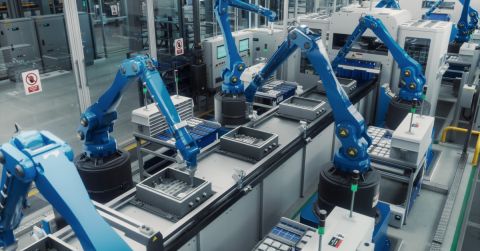Semiconductor Foundry Capacity: Who, Where, and How Much
The biggest electronics story in the US in 2022 was the Chips Act, which allocated large public investment amounts into semiconductor manufacturing capacity. This was followed by large amounts of corporate investment into new production facilities in the US, as well as investment by US companies in other parts of North America and Europe. In total, the level of US investment has reached hundreds of billions of dollars by companies like TSMC, Intel, Samsung, Micron, and Texas Instruments. European investment has also increased in concordance with US companies and government investment.
To really see the effects on the electronics supply chain, one has to look at the global picture, which involves investment in Southeast Asia. What’s also important is the type of investment; the investment in much of Southeast Asia is in foundry capacity, while the US investment is primarily in captive manufacturing capacity. There is also growth in OSAT capacity to consider, which is growing fastest in Southeast Asia.
Foundry vs. Captive Capacity
The biggest change in the semiconductor business over the past 20 years has been the growth of foundry operations, such as TSMC and Samsung foundry. These businesses don’t produce any of their own products and only focus on developing expertise in semiconductor fabrication, as well as related disciplines like packaging. New semiconductor factories being built in the US, Europe, and Asia include foundry capacity and captive operations manufacturing a company’s own products.
First, the short statistic: US companies are experiencing the greatest expansion in terms of new facilities or add-ons to existing facilities. Within the US, there are 73 new semiconductor fabs planned for construction or currently under construction. Of this number, US companies are building 50 brand new facilities, and 42% of those brand new facilities are located in the US. That’s a significant amount of new capacity within US borders or in locations that are friendly to US companies.
When we look at technology node, we see interesting statistics on the location of the most advanced capacity. As shown in the table below, capacity for the most advanced nodes is found in Asia, specifically in Taiwan and Japan. This aids companies that wants to implement an effective China +1 strategy and who need more advanced chips for their products.
|
Company and Location |
Technology Node |
|
2 nm and 1 nm |
|
5 nm and 4 nm |
|
7 nm |
Next, let’s look at what is arguably a more important set of numbers: foundry capacity. There are a few ways to measure foundry capacity, but the industry standard (and probably most important) is the monthly wafer capacity. The following list gives monthly wafer capacity values at new foundry operations across the globe:
- Winbond Electronics Corp.
- 10,000
- United Microelectronic Corp.
- 30,000
- Samsung Foundry
- 30,000
- TSMC (Japan)
- 55,000 (Japan)
- 20,000 (United States)
- Nanya Technology Corp.
- 45,000
- Foxconn
- 40,000 (India)
- 40,000 (Malaysia)
- Tower Semiconductor Ltd.
- 40,000
- Hua Hong Semiconductor Ltd.
- 83,000
- Powerchip Semiconductor Manufacturing Corp.
- 100,000
- Guangzhou CanSemi Technology Inc.
- 120,000
- Semiconductor Manufacturing International Corp.
- 340,000
Not all foundry facilities are created equal because fabs are only capable of producing at certain technology nodes. From looking at the geographic distribution of fabrication capacity, we see clear dispersion in the location of foundry capacity; most of the new capacity is located in China, but the most advanced capacity is outside of China in Taiwan, Japan, South Korea, and to a lesser extent in the US.
One wildcard that is conspicuously absent from the above list is Europe. There is a European Chips Act, which was passed on 25 July 2023. The goal of the European Chips Act is to facilitate an increase in chip production and thus grow the European market share of global manufacturing capacity and capability. As EU allocations begin to be disbursed, it is likely that private investment will follow to help grow Europe’s semiconductor manufacturing capacity.
OSATs and IDM A&T Capacity
Chips can’t exist in a vacuum, and as semiconductor production capacity grows so must the assembly and test capacity. There are two models for assembling chips into packages and bringing them to market: outsourced assembly and test (OSAT), and integrated device manufacturer assembly and test (IDM A&T).
The OSAT market is even more fragmented and vulnerable than the foundry market, as indicated by the following statistics.
- Nine of the top 10 OSAT vendors are located in the Asia/Pacific region (Silicon Semiconductor)
- The number of OSAT facilities in China and Taiwan outnumbers OSAT facilities in all other regions combined (semi.org)
- OSAT growth in APAC region outpaces North America (Anysilicon)
Without increased OSAT or IDM A&T capacity in the same regions as semiconductor manufacturing, there is no point in localizing semiconductor production as chips will still need to be sent overseas to be assembled into their packaging. In the US, the Chips Act does provide an allocation to the National Advanced Packaging Manufacturing Program (NAPMP), which aims to build an advanced packaging ecosystem within the US.
As more capacity and inventory enters the electronics market, Octopart will be here to bring you the newest developments. Whenever you need to find components for your BOM, use the advanced search and filtration features to locate the right parts and sources and plan your component orders. You will also find suggested alternates on Octopart’s component pages and up-to-date distributor pricing data, parts inventory, and parts specifications.
Stay up-to-date with our latest articles by signing up for our newsletter.










